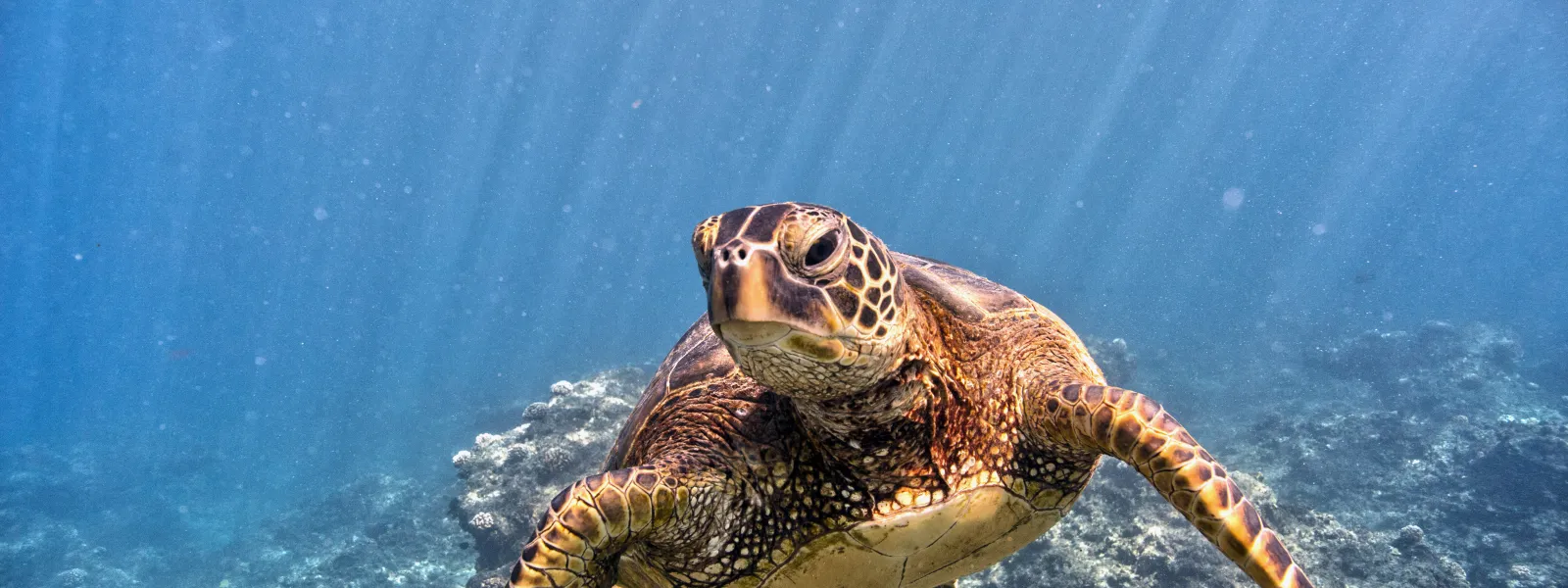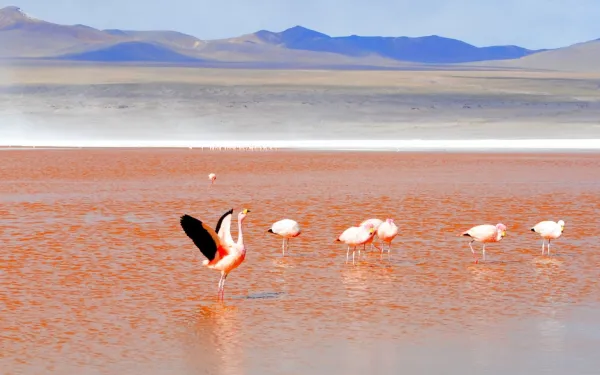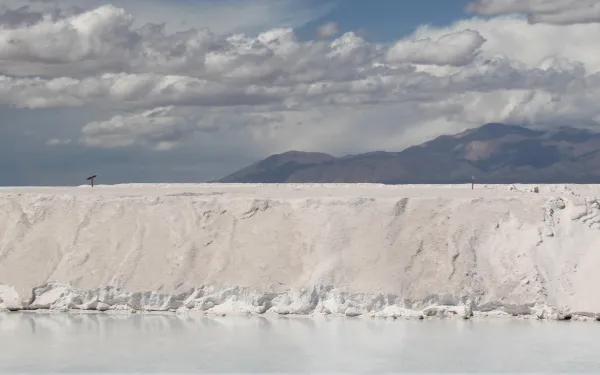
Project
Victory: Court ends the “lawful” killing of endangered green sea turtles
In February of 1999, the Constitutional Court in Costa Rica declared an end to the "lawful" killing of endangered green sea turtles. The ruling is an important victory for the green sea turtle and potentially other species left vulnerable by their host countries.
Costa Rica has the privilege and responsibility of being a haven for one of the largest remaining populations of this endangered species of marine turtle in the Atlantic Ocean. Every two or three years, female green sea turtles, many of which are decades old, slowly plod from their ocean homes to nest on a 35 kilometer long beach between the Tortuguero and Parismina River.
Costa Rica, rather than fully protecting these ancient guests, previously had a law allowing for the capture and slaughter of almost two thousand green sea turtles annually. Unfortunately, poachers exploited the law to kill many more than the legal limit, with the survival of the sea turtles jeopardized.
In response to inaction by the Costa Rican government, and to safeguard the survival of the green sea turtle, AIDA worked through its partner organization CEDARENA to file suit and challenge the law.
In the law suit, AIDA and CEDARENA argued that the law violated the Costa Rican constitutional guarantee of an environment that is healthy and “in ecological equilibrium.” We presented hard evidence of the hidden impact of the law on the sea turtles. The Court ruled in our favor, and annulled the law.
The ruling itself does not end the threat to green sea turtles. It may however, provide some breathing room for conservationists to concentrate on stopping illegal poaching. Hopefully, they will succeed.
Related projects

Justice for Andean Wetlands and Indigenous Peoples in Climate Action
The growing global demand for transition minerals—including lithium, copper, and nickel—driven by the current energy transition model, but also by the expansion of the digital economy, data infrastructure, and the military and aerospace industries, is causing irreversible ecological damage and violating fundamental human rights across the territories of the Global South. Latin America is the most biodiverse region on the planet and one of the most culturally diverse regions in the world. It is home to numerous Indigenous peoples who inhabit and safeguard these territories.At the same time, the region holds significant mineral deposits, placing it at the center of the growing global interest in mineral extraction. This demand intersects with fragile ecosystems, unique biodiversity and the territories of traditional and Indigenous communities, including the Amazon and the high Andean wetlands, which are crucial for climate adaptation due to their role in water regulation, and in mitigation, as they act as carbon sinks.Intensive mining in these ecosystems exacerbates climate vulnerability and fosters socio-environmental conflicts, compromising the ecological and cultural integrity of these ecosystems and communities. The push to expand extraction contradicts multilateral environmental protection frameworks and the climate and biodiversity commitments adopted by the States Parties. This trend jeopardizes the possibility of a just and equitable transition, reproducing the same patterns of inequality and climate harm that current policies claim to overcome. In this context, the Alliance for Andean Wetlands calls on States Parties to the UNFCCC to ensure: 1. Human rights and justice must be at the center of any transition and of all strategies for climate change adaptation and mitigation, including the rights of communities living in territories where the transition minerals are located.Human rights are essential to ensuring a just, equitable and people-centred process. States must guarantee the right to self-determination of Indigenous peoples, recognized worldwide as guardians of natural systems. This must encompass their right to define their own development priorities and to exercise Free, Prior and Informed Consent (FPIC), as well as the unequivocal obligation of States to respect their decisions, particularly their right to say “no” to projects that threaten their integrity and that of their territories. States must also ensure protection of environmental defenders, and guarantee public access to information, participation and justice on decisions about transitions that might affect the environment and human rights. These guarantees are crucial for the case of so-called transition minerals, like lithium and copper, found in the high Andean wetlands, ecosystems that are fundamental to life, ecological and climate balance, and the livelihoods of the communities that inhabit them. 2. Respect of planetary boundaries and the protection of the integrity of ecosystems, particularly those that play essential roles in climate adaptation and mitigation.Keeping ecosystems such as Andean wetlands, which are of high ecosystemic and cultural value, free from high-impact activities is a priority for climate and ecological justice. Because lithium mining is water mining, it drains already scarce water sources and severely affects surrounding ecosystems, leaving lasting environmental damage.To preserve the high Andean wetlands and their contributions on which life in the region and on the planet depends, States must fully respect and comply with international environmental law; adopt and strengthen effective protection measures (including the establishment of “no-go zones”, protected areas, ICCAs); and apply robust and science-based environmental planning instruments that seek to prevent environmental damage (i.e. environmental strategic and cumulative impact assessment, environmental impact assessment).Effective environmental protection also requires up-to-date knowledge of ecosystem structure, functioning, and contributions, developed through collective and democratic processes, integrating traditional knowledge and practices of Indigenous Peoples and local communities. Parties should systematically incorporate scientific advances and traditional knowledge into climate-related decisions, including the design and implementation of their Nationally Determined Contributions (NDCs) and related roadmaps, to ensure commitments reflect the realities of the territories they aim to protect. 3. Support for socio-ecological transitions for the Global South.Countries in the Global South need enough fiscal and policy space to devise pathways out of fossil fuels that do not reproduce existing asymmetries and inequalities, or further extractivism. This calls for socio-ecological transitions that protect local economies while ensuring economic diversification, energy access, and energy sufficiency, respect for biodiversity, and human rights.These transition paths should be planned, implemented and monitored in a participatory manner, ensuring intersectional, intercultural and intergenerational participation. The Just Transition Work Programme (JTWP) under the UNFCCC provides a crucial space to integrate these concerns into global climate governance. It must ensure that the transition towards decarbonization also addresses material demand, territorial justice, and the rights of affected communities. Incorporating the realities of mineral extraction and socio-ecological transitions from the Global South within this programme is essential to achieve a truly just transition. 4. Traceability of the projections and uses of mineral demand and commitment of Global North countries to rapidly adopt policies aimed at reducing the consumption of primary minerals and energy.The current production and consumption model of industrialized countries disproportionately affects territories in the Global South by exacerbating environmental degradation and the violation of human rights, deepening North– South inequalities. In order to tackle the triple planetary crisis, unsustainable demand for raw materials and energy has to be addressed by binding targets on demand reduction that take into account planetary boundaries. Parties have the opportunity to include them in policy instruments such as Nationally Determined Contributions (NDC) and Long Term Strategies (LTS).These must be implemented through sufficiency and efficiency measures, as well as global and fair circular economy policies. This should involve considering alternatives to mobility beyond individual EVs. 5. Adequate, quality, accessible and additional financial and technical support, based on needs and priorities, so that the energy and socio-ecological transitions of the Global South are truly just and equitable.Such financing must be sustainable in time and of quality, that is, non-debt-creating and aligned with countries’ priorities, and accessible to enable progressive and sustained climate action. It should also address opportunities and conditions for instruments that foster fair transitions, including debt relief mechanisms and debt swaps. Furthermore, it remains important to discourage the use of trade regimes (including ISDS mechanisms) as pressure tools against countries in the Global South when they seek to regulate their mineral resources and establish no-go zones and other safeguards to protect human rights and environmental integrity. Download the document
Read more
Call for a paradigm shift in EU Raw Materials Policies from a Latin American perspective
The growing global demand for transition minerals—including lithium, copper, and nickel—driven by the current energy transition model, but also by the expansion of the digital economy, data infrastructure, and the military and aerospace industries, is causing irreversible ecological damage and violating fundamental human rights across the territories of the Global South. Latin America is the most biodiverse region on the planet and one of the richest regions in cultural diversity. It is home to numerous indigenous peoples who inhabit and safeguard these territories. At the same time, it contains significant mineral deposits, creating an intersection between the growing global interest in mineral extraction and fragile ecosystems and territories of traditional and indigenous communities, such as the Amazon and the Andean wetlands. This scenario exacerbates climate vulnerability and creates the conditions for the emergence of socio-environmental conflicts, compromising the ecological and cultural integrity of these territories. The push for scaling up extraction contradicts multilateral frameworks as well as climate and biodiversity commitments that the EU has subscribed to. This tendency bears the risk of reproducing the same patterns of global inequality and climate damage these policies claim to overcome. The Alliance for Andean Wetlands calls on the European Union to adopt measures for a paradigm shift towards Raw Materials Policies that do not perpetuate inequalities and harm people and ecosystems, by: 1. Ensuring full compliance with its binding international human rights obligations and maintaining its high standards of human rights and environmental due diligence. The current debates on deregulation raise concerns about the EU's seriousness in implementing human rights and environmental safeguards along minerals value chains and in global gateway projects. In this context, the EU should not support: (i) the weakening of the provisions of the Corporate Sustainability Due Diligence Directive (CSDDD), an essential lever for holding EU companies accountable for their activities within and outside the region; and (ii) the privatisation of the implementation of international human rights and environmental standards. All forms of corporate self-regulation, such as multi-stakeholder initiatives, industry schemes, or third-party audits, are insufficient to demonstrate compliance with these standards and may undermine states' and companies' obligations. In this regard, legal frameworks should be sufficient to guarantee that corporations are held liable throughout the supply chain of critical minerals according to EU directives. This is a particularly sensitive question as it also challenges the existing regional human rights system, represented by the Inter-American Court of Human Rights, which has produced valuable precedents and jurisprudence on the matter for the past 45 years. 2. Guaranteeing maximum transparency, access to information, and inclusive participation of affected communities and civil society in the Global South. Ensuring early and effective involvement of civil society and indigenous and local communities affected by strategic projects, strategic partnerships, global gateway, and other initiatives. This involves guaranteeing the right to self-determination; to free, prior, and informed consent (FPIC) of indigenous peoples, and the respect for their right to say ‘no’ (RTSN). Undermining the voices from local communities and civil society increases social, ecological, and operational risks, especially mining projects likely to entail cumulative or long-term environmental impacts, particularly those involving extraction methods with potentially significant adverse effects on water, such as direct lithium extraction (DLE) or evaporation techniques. In contrast, including them is not only ethical but also essential for a just transition, the long-term viability of projects, and for preventing companies from facing future legal liabilities. 3. Challenging the projections of transition raw materials demand and rapidly adopting policies to reduce the production and consumption of primary minerals in the EU. The EU should set binding, ambitious, and measurable targets on energy and material reduction, taking into account planetary boundaries. In addition, conducting a prior, comprehensive, and independent strategic assessment of minerals needs and of alternatives to their extraction is essential to uphold the principle of proportionality, achieve climate objectives through less harmful means, and avoid irreversible damage to communities and ecosystems. Moreover, the EU should also foster more comprehensive circular economy strategies that take into account local economies and the biophysical limits of the ecosystems. Download the document
Read more
Protecting the Environment Through Collaboration: A Community Science Experience
When environmental damage occurs, the first warning often comes from the people or communities directly affected. Residents living near a river are usually the first to notice waste being dumped or fish dying when the water is polluted. Similarly, who live near an open pit mine are the who see when illness becomes more common or when water begins to run scarce.One powerful way to turn lived experience into scientific evidence is through community science. This approach allows people to share, validate, and integrate local knowledge into scientific research and efforts to defend their territories.At AIDA, we believe in the power of science to advance environmental justice. That’s why we generate and apply scientific knowledge in the legal cases we support. Recently, we had the opportunity to take part in a community science initiative that helped us reflect on—and learn from—the value of this collaborative methodology and the shared knowledge it produces. Local Knowledge: A Powerful Response to Environmental Degradation In April 2024, at the request of the Poqomam Maya community of Santa Cruz Chinautla—a village near Guatemala’s capital—AIDA senior scientist Javier Oviedo and attorney Bryslie Cifuentes carried out a field visit to gather information and assess the solid waste pollution that has affected the community for years.One of their main objectives was to identify illegal dump sites on the banks of the Chinautla River. The disposal of waste and debris in this area has contaminated both the soil and waters of this tributary of the Motagua River, the longest river in Guatemala.While preparing for the trip, Javier realized the team would face several challenges. The time available would not be enough to collect all the necessary data, and the team’s limited familiarity with the area could make locating the dumpsites difficult and potentially unsafe.Then Javier had an idea: to involve members of the community in supporting the team with this task.His plan made perfect sense—after all, who better to locate the illegal dumpsites than the people who know the territory best? Beyond that, by witnessing the impacts of pollution firsthand, community members could also appreciate the importance of documenting these issues.I spoke with Javier about how this idea came about, and he shared the following: Beyond seeking support from community members, this approach was rooted in a recognition of the irreplaceable value of their knowledge as residents of their territory. How the Work Was Carried Out Javier’s idea was that, with the help of an accessible and easy-to-use mobile app, community members could send information about illegal landfills directly to the AIDA Science team, who would then validate and analyze the data.To make this possible, the team designed a form specifying the data they needed to collect: the location of the landfill, its dimensions, the type of waste identified, associated social issues, and other relevant details.In Chinautla, two community residents, along with authorities from the Poqomam Maya village, visited several landfills they had previously identified with Javier and Bryslie. During these visits, Javier showed them how to use the app and fill out the form. Later, one of the residents continued the process independently.Thanks to this collaborative effort, data was collected on 10 of the most critical illegal dumpsites. While this does not capture all of them—unfortunately, many more exist—this sample allowed the team to estimate the extent of waste and debris pollution in the community and to illustrate how poor management has exacerbated the problem.The information gathered was crucial in highlighting the severity of the pollution, demonstrating the continued use of illegal dumping, and exposing the municipal authorities’ failure to meet their legal obligations regarding waste management.This evidence formed the basis for the lawsuit the community filed against the municipality of Chinautla in October 2024, citing the lack of measures to address river and soil contamination caused by inadequate waste management and illegal landfills. In June 2025, an appeals court ordered the municipality to take action to address the serious environmental crisis affecting the community. Lessons Learned from the Experience According to Javier, involving the people of Chinautla in a knowledge-building process led to mutual learning.For community members, it meant acquiring new technological skills. For the AIDA team, it prompted new questions about how to move knowledge-sharing with a community beyond simple collaboration.Javier summarized his learnings in three points: At AIDA, science is a core part of our work and a key element of the strategic litigation we pursue to protect and defend a healthy environment across Latin America. Involving the communities we support in this process broadens our perspective, allowing us to integrate their knowledge and experiences into the science we seek to build.
Read more